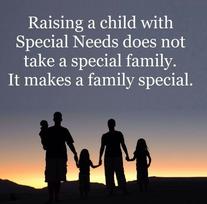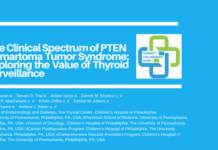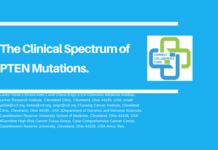 Many children with PTEN hamartoma tumor syndrome (PHTS) have neurodevelopmental conditions such as autism. These children have distinct strengths and challenges in addition to those commonly seen in PHTS without neurodevelopmental issues. In 2016, our team at the Cleveland Clinic Children’s Center for Autism published the first comprehensive description of PHTS with autism.
Many children with PTEN hamartoma tumor syndrome (PHTS) have neurodevelopmental conditions such as autism. These children have distinct strengths and challenges in addition to those commonly seen in PHTS without neurodevelopmental issues. In 2016, our team at the Cleveland Clinic Children’s Center for Autism published the first comprehensive description of PHTS with autism.
We found that affected children, adolescents, and young adults tend to have significant challenges with mental processing speed and working memory. In other words, they struggle with rapidly processing incoming information and then holding that information in their minds long enough to guide their actions.
Their challenges with working memory and mental processing proved even greater, on average, that what we see in other children on the autism spectrum. Like many people with autism, some individuals with PHTS and autism also have problematic sensitivities to certain sights, sounds and textures and/or difficulty screening out distracting stimuli. At the same time, we did not see overall differences in the severity of core autism symptoms. In other words, their challenges in social communication and repetitive behaviors tended to be like those of other children on the autism spectrum.
We likewise saw a wide range of symptoms and associated challenges, which is also typical of autism. This ranged from mild autism symptoms and average cognitive, or intellectual, abilities to severe autism symptoms with impaired cognition (intellectual disability). These findings reinforce the importance of tailoring interventions and support services for each child, teen, or adult. Along these lines, we developed tailored advice for three distinct groups, as well as general advice for supporting anyone affected by PHTS and autism. As follows: 
Group 1: Young children
Young children with PHTS and autism may require early behavioral interventions to optimize daily functioning and learning. Even among children with strong cognitive skills, early intervention can minimize daily challenges such as resistance to change, while broadening interests and promoting social development. For young children with cognitive impairments, early and intensive intervention is particularly important for improving social communication skills. As appropriate, strategies can include the use of a speech-generating device or picture-exchange system and behavioral therapy aimed at decreasing repetitive behaviors and expanding restricted interests as well as step-wise learning of daily living and social skills. In addition, parent training and behavioral and/or medical treatment are crucial when a child is affected by one or more of the health issues that commonly accompany autism. These include disrupted sleep, anxiety, sensory aversions and challenging behaviors. We empower parents when we teach them how to engage with their young children, ease their emotional issues, improve their sleep and replace problematic behaviors with those that increase the quality of life.
Even a short burst of parent training in behavioral strategies can produce lasting benefits for many children and their families.
Group 2: Older children and teens with significant cognitive impairments
The intervention needs of young children often apply to older youth with cognitive impairments. Many older children and teens in this group benefit from an intensive behavioral teaching approach that addresses skills needed for success in school and daily living. It’s important to tailor these social-communication interventions so they make sense to the older child or teen. This includes progressive teaching and reinforcement of social communication strategies that enhance the ability to socialize with others and to ask for what one needs in socially appropriate ways. Such skills go far in improving quality of life for both the child and the family.
Importantly, parents should know that they don’t need to “go it alone.†I encourage them to look for parental support programs in their community, county, and state, in addition to opportunities for financial support and publicly funded therapies for their children. It’s encouraging to see many states and communities increasing the options available to children, adolescents, and adults with autism. So stay connected and continue to inquire.
Group 3: Older children and adolescents with average or above cognitive ability
Social skills tend to rank among the chief challenges when autism affects a child or teen with average or above-average cognitive abilities. Building social skills is an ongoing process that needs to be tailored to each child’s unique – and changing – challenges and strengths. This includes building on personal interests and social motivations. Typically, the most successful interventions combine behavioral and cognitive approaches. The behavioral aspect involves positive feedback to reinforce each step toward mastering an appropriate behavior. Take, for example, the step-wise mastery of acceptable table manners. The cognitive aspect involves learning the “language†of social interactions. This can include learning to maintain an appropriate distance when talking along with the steps to initiating, maintaining and ending conversations. Many cognitively able older children and teens do well in a social skills training and support group.
We’re seeing a growing number of such programs, some covered by health insurance and some included in special education programming. In addition, many individuals with milder impairments do well in a supportive community group such as a church “night out” or after-school club. I encourage parents to seek out more information about local programs. For instance, ask the leaders of a social-skills support group about their training, experience level and the cognitive and/or behavioral approaches they use. Do they base their program on evidence-based strategies (methods that researchers have evaluated and found effective)?
General advice
As a general strategy, keep in mind PHTS-related difficulties with working memory and processing speed. It’s remarkable how effective it can be to simply speak more slowly, especially when giving directions. Of course, you want to personalize this approach to avoid making the child, teen or adult feel “talked down to.” These strategies are likewise important for teachers, therapists, and other caregivers. In particular, I recommend talking with teachers about these working memory and mental processing challenges. Otherwise, the fast pace of instruction in a classroom can prove overwhelming.
The best educational approaches often include presenting information in multiple ways (e.g. with written, spoken and highly visual content) and in a slower, more deliberate fashion. It can also help to repeat information and/or ask questions to check that information is entering working memory.
Capitalizing on strengths
Just as importantly, I urge parents and other caregivers to keep mindful of the strengths that frequently accompany PHTS. One of the most remarkable and common is high social motivation, sincere interest in others and a desire for close contact with loved ones.
We’ve also observed that some children with PHTS and autism show greater cognitive flexibility – or an ability to “go with the flow” – than is typical of others on the autism spectrum. When they do struggle with changes in routine, the associated anxiety and resistance can be milder than is typical with autism.
Looking for and playing to strengths such as these can prove extremely helpful when supporting daily function and learning, and addressing challenging behaviors.
Inspiration for parents
As parents, many of us have felt unprepared to meet the challenges that a neurodevelopmental condition poses for our children. It helps to remind ourselves of the moments that give meaning to our lives, provide us with a sense of purpose and encourage us to be better people.
My colleagues and I are continually inspired by the many families and caregivers who work with us. Their resilience and positive outlook exemplify how challenges can become opportunities. Below is some general advice that can maximize this transformative process.
- Positive reinforcement consistently proves more effective than punishment. It also avoids promoting aggression. Focus on gradually shaping behaviors with positive reinforcement. Your child’s therapist and/or healthcare provider can help you find behavioral training programs for parents of children with developmental disabilities.
- Focus on daily and weekly pleasures. Make sure each week has small, pleasurable experiences, like sharing some popcorn or going on a family walk. Such daily pleasures can enhance happiness and quality of life more than, say, a yearly vacation or even a monthly trip to a favorite place.
- Try to balance accommodating your child’s challenges with addressing or remediating them. In other words, there may be times when it’s more appropriate to make allowances than work on change. This requires a thoughtful approach to deciding when working on a new skill is developmentally appropriate and has real value for your child. Listen to your instincts but also get input from your child’s therapists when deciding how and when to introduce new targets.
- Parenting any child can be draining. Respect that you can and will get tired and frustrated. See if you can trade off with other parents and caregivers. I recommend having mutually understood buzz words like “I need a break” so that you can get prompt relief when needed. If you don’t have other caregivers for mutual support, talk with your child’s therapist, teacher or healthcare provider about available community supports for parents of special-needs children.
- Schedule time for yourself and your important relationships with your spouse, other children and extended family and friends.
- Keep a written record of your child’s new skills, particularly if his or her development feels slow and gradual. It can be a tremendously motivating way to see all the milestones your child has reached over the years. It’s important confirmation that your hard work as a parent is paying off.
I hope this advice and perspective proves helpful. I want all parents of children with neurodevelopmental conditions to realize that this journey can be the most rewarding experience of their lives. Enjoy it and keep up the good work!
– Thomas Frazier, Autism Speaks Chief Science Officer







